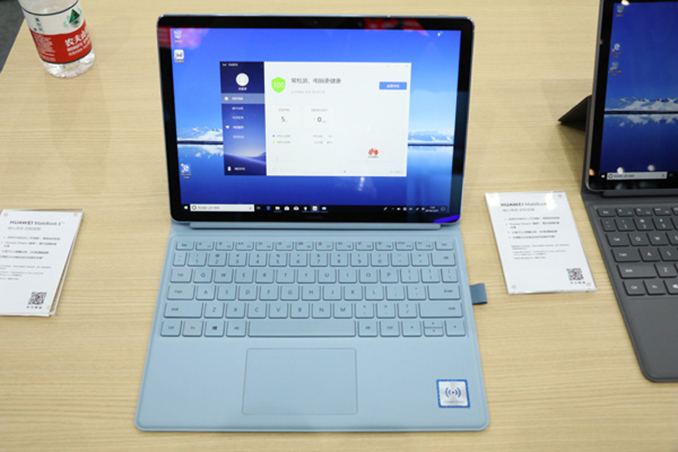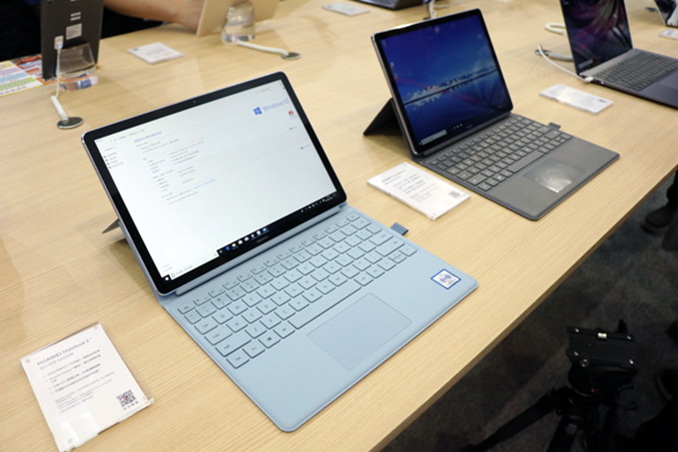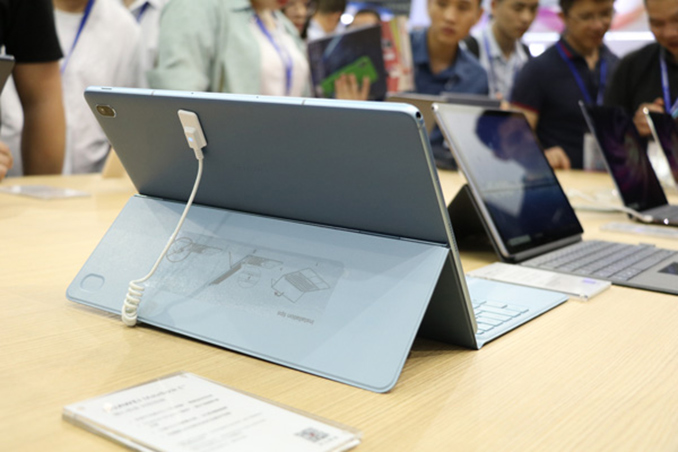Huawei Readies Windows 10 Laptop Based on Qualcomm Snapdragon 850
by Anton Shilov on April 11, 2019 4:00 PM EST- Posted in
- Laptops
- Qualcomm
- Huawei
- Notebooks
- 2-in-1
- Matebook E
- Snapdragon 850

Being a relatively new maker of laptops, Huawei is trying to address high-end and niche markets to gain share, avoid direct competition with numerous rivals at the same time, and preserve its profit margins. With numerous ultra-portable Intel Core-based notebooks in its arsenal, Huawei is working on a Windows 10 on Snapdragon 2-in-1 PC for those who want an always-connected machine.
The Huawei Matebook E 2019 is actually even more portable than the company’s existing offerings. The convertible 2-in-1 notebook comes equipped with a 12-inch display featuring a 2160×1440 resolution, 400 nits brightness, and a 3:2 aspect ratio. The chassis of the tablet (as well as its kickstand) is made of an unknown metal alloy and is 8.5 mm thick, which is a tad thicker when compared to other offerings in this segment. Meanwhile, the tablet itself weighs 690 grams without its keyboard cover and about a kilogram with it, bringing the weight of the whole system to the level comparable with ultra-light notebooks. Speaking of keyboard, it has a relatively large touchpad and an NFC chip to enable Huawei’s Share OneHop service, but no backlighting. Besides, it can hold Huawei’s M-Pen stylus.
The Matebook E is based on the Qualcomm Snapdragon 850 SoC (four Kryo 385 cores at 2.96 GHz, four Kryo 385 cores at 1.7 GHz, Adreno 630 GPU) which is accompanied by 4 or 8 GB of LPDDR4X memory as well as 128 or 256 GB of USF NAND flash storage (it is unclear whether it is expandable using a microSD card). Since we are dealing with a machine powered by a platform originally designed with mobility and connectivity in mind, the Matebook E supports everything you come to expect from an Always Connected PC (ACPC), including the X20 LTE modem (Cat 18, 5CA, 4x4 MIMO, up to 1.2 Gbps DL, up to 150 Mbps U, 802.11ac Wi-Fi, and Bluetooth 4.1. Interestingly, the Matebook E is outfitted with an eSIM, but also has a slot for a regular nano SIM card.
The tablet also has a USB Type-C connector, a fingerprint reader, two stereo speakers, and a 3.5-mm TRRS audio jack. Obviously for a 2-in-1 form-factor, the Matebook E feature the same set of sensors as regular tablets, including an accelerometer, a gyro, a light sensor, and so on. As for battery, it has a built-in 36.3 Wh battery that can last up to 20 hours.
When it comes to imaging, the 2-in-1 notebook has a 20 MP main cam with autofocus and a LED flash, as well as a 5 MP camera for selfies.
Huawei plans to launch its Matebook E 2-in-1 convertible in China already next month, but it is unclear when and if the company intends to release it on other markets as well.
| Specifications of Huawei's Windows on Arm 2-in-1 | ||
| Matebook E 2019 | ||
| Display | 12-inch, 2160×1440 216 PPI |
|
| CPU | Qualcomm Snapdragon 850 4 x Kryo 385 at 2.96 GHz 4 x Kryo 385 at 1.7 GHz |
|
| Graphics | Adreno 630 GB | |
| RAM | 4 or 8 GB LPDDR4X | |
| Storage | 128 or 256 GB UFS | |
| Wi-Fi | 802.11ac Wi-Fi | |
| Bluetooth | 4.1 | |
| WWAN | Qualcomm X20 Gigabit LTE Cat 18, 5CA, 4x4 MIMO, up to 1.2 Gbps DL, up to 150 Mbps UL |
|
| USB | 3.0 | 1 × Type-C |
| Cameras | Front | 5 MP |
| Rear | 20 MP | |
| Other I/O | Microphone, stereo speakers, audio jack, trackpad, etc. | |
| Battery | 36.3 Wh | |
| Battery Life | 20 hours | |
| Dimensions | Width | ? |
| Height | ? | |
| Thickness | 8.5 mm | |
| Weight | Tablet | 690 grams |
| Tablet+KB | ~1000 grams | |
| Price | ? | |
Why Snapdragon and not Kirin?
Ian: When we were at Mobile World Congress, I put it to HiSilicon if they were planning to build a chip for Windows based notebooks with the name Kirin. They said that they were not, for the simple reason that the market is not yet mature. They are more than happy to let other chip manufacturers build a market first, before they insert their own hardware, and would potentially join a mature market, but not at this time. Despite this, this new product shows that Huawei is willing to at least dip its toe into the water with the already verified solutions on the market, even if it isn't Huawei's own chips just yet.
Related Reading
- Samsung Unveils Galaxy Book2: 12-Inch, Snapdragon 850 with X20 LTE, 20 Hrs
- Lenovo Announces Yoga C630: The First Windows on Snapdragon 850
- Qualcomm Announces Snapdragon 850: A Second Generation For Windows
- Lenovo’s Miix 630 Snapdragon 835-Based 2-in-1 Now Available
- HP’s Snapdragon 835-Based Envy X2 2-in-1 Available for Pre-Order, Starts at $999
- Lenovo Unveils Miix 630 2-in-1: Windows 10 S, Snapdragon 835, Gigabit LTE, 20 Hrs
- ASUS Announces the NovaGo (TP370): A Snapdragon 835 based Windows 10 PC
Source: NotebookItalia.it (via Liliputing)













39 Comments
View All Comments
abufrejoval - Thursday, April 11, 2019 - link
I don’t understand why they are waiting for Windows to deliver that hardware. These days most of what you need to be productive on a notebook is quite capably delivered also by a “normal” Linux desktop or Linux running an Android user-land: Mostly browsers and an office suite. Firefox or Chromium *do* run natively on Android and on Ubuntu ARM64 (or Fedora for that matter) and with a Cinnamon desktop the switch between a ‘sane’ Windows 10 (with Classic Shell) and Linux is much less of a ‘culture shock’ than say MacOS (Gnome for ex-Mac’s works, too).I am running both Android-x86-64 via a Phoenix desktop and AMD64 Ubuntu with Cinnamon on Atom desktops and notebooks and I am also running a native ARM64 Cinnamon on the Nvidia Jetson Nano at 4k. All are quite capable of sustaining a normal bureaucratic workload, while Atoms and the cut-down Tegra X1 are significantly slower than a Snapdragon 850 (or even an 820 for that matter).
Getting Ubuntu for ARM64 to run Android applications should really be little more than a finger exercise, when it’s already fairly well working on x86 with Anbox (where you still need to add emulation in the other direction to run ARM native code on x86) and that opens up the use of Microsoft Office for Android on Ubuntu for those who insist, only Microsoft can do Office properly.
My impression is that Microsoft is banging the Windows on ARM drum so much is that they are very much afraid that Snapdragon CPUs might actually gain Linux the type of headway on the desktop, that they have worked very hard to avoid on x86. If you really need native Windows, I’d say you’re much better running that on VDI or terminal services, for which clients exist on every OS.
I believe the Microsoft AppStore monopoly already is a significant reason to avoid Windows on ARM like the pest, but on top I believe vendors and consumers are making a serious mistake waiting for Windows on ARM to catch up before selling/buying seriously capable Linux desktop hardware in an ultrabook form factor at better performance/power specs than anything that Intel and Microsoft can deliver.
Of course it would help if vendors wouldn't try to sell these ultrabooks at i7 prices. Well, sure, go ahead and sell some magnesium premium to those who like to throw their money around, but please, pretty please, also sell a variant with lots more plastic, 12 hour battery, good-enough keyboard and display for the price of an Atom notebook.
Actually a Chuwi 12.3 with Snapdragon 835-855 would do just fine for me at the same price point as the Atom variant (without Windows of course).
cfenton - Friday, April 12, 2019 - link
Linux is a very tough sell for most consumers. As soon as the solution to a problem involves going to the terminal, you've lost 99% of users.I run Mint with KDE on one of my laptops, and most of the time it works well enough that I could recommend it to a normal user. However, every once in a while I'll run into weird issues that require a lot of Googling and fiddling to fix. Most recently, my CPU stopped using its turbo frequencies. Fixing it required editing a config file after doing a bunch of diagnostics in the terminal. It was annoying for me to fix, but it would have been nearly impossible for most of my family to fix.
sorten - Thursday, April 11, 2019 - link
I don't get this segment. These machines end up being as expensive as last year's Surface Pro, so it's not a value proposition and then you're giving up massive amounts of performance and functionality so you can stay unplugged for a couple more hours?OTOH, if you're looking for that long battery life and are willing to go with the "ACPC" form factor then why not buy a chrome book, which was custom built for that purpose from day one.
abufrejoval - Thursday, April 11, 2019 - link
From a purely technical point of view I'd agree. Especially if they were to sell a Chromebook with a recent Snapdragon.But a Chromebook is more of a Google terminal than a Personal Computer: I want them broken into more mini-Bells than there are letters in Alphabet, not owning my personal data.
So if I could convert such a Chromebook into a Google-less PC at say $300-400, I'd hit the order button right now.
neblogai - Friday, April 12, 2019 - link
Would it be able to emulate old/light games, created in Win98-WinXP-Win7 era that run on Win10, without any issue? Like Fallout1/2, Heroes3, Nolf2, FTL?eastcoast_pete - Friday, April 12, 2019 - link
Here yet another possible reason for Huawei using the SD 850 instead of their Kirin: If this whole "Windows on ARM" thing goes down in flames, the Kirin brand name won't be tarnished by that potential fiasco. If Windows on ARM takes off, Huawei can start using its own chips in the next iteration of ultralight portable laptops and 2-in-1s.edzieba - Friday, April 12, 2019 - link
I don't see this going any better than every single previous Windows on ARM attempt has.digiguy - Friday, April 12, 2019 - link
WOA could be the next revolution. Contrary to the past, top ARM CPUs are already on par with the best Intel 15w CPUs... And now with Chrome and Firefox onboard, and Windows and Office already there, a lot will be native. The make or break thing will be the price. If these laptops are priced competitively they could be the next revolution. It's not just battery life, stand-by time is a major thing... The time to ditch Intel cannot come soon enough...nobodyblog - Sunday, April 14, 2019 - link
ARM high performance only has great speed in benchmarks.. For around 30 seconds. Then, they are slow..... And the battery life isn't better than Intel at all.... Just ignorant people think ARM is more power efficient. They are only when speed is much lower. Intel's LATEST 14nm Whiskey Lake is *much* faster and more power efficient than ipad A12x. See Mate Book pro X powered by Whiskey Lake vs ipad pro. No OS, even they didn't use Intel's iGPU and low power display. Its battery is smaller than ipad pro. And it has the same Wattages without trottlng..